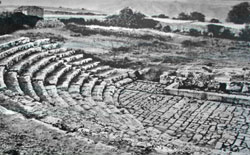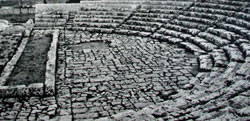
Akrai
Ancient Akrai, a colony of Syracuse founded in 664 BC, survived until the Arab period and was later replaced by medieval Palazzolo. But conspicuous monuments remain of the Greek colony. They were explored by Gabriele Iudica in the 19th century. Luigi Bernab˛ Brea conducted important excavations on the site from 1950 on and especially from 1963, when the main lines of the town plan were revealed. The small theatre, certainly no later than Hiero II (3rd century BC), presents a regular plan. The orchestra had the form of a perfect semicircle. The cavea, the area of tiered seating, was also semicircular, rather than horseshoe shaped; it was hewn into the hillside and divided into nine segments by eight stairways. The scaena must have had a colonnaded or pilaster-fronted logeion. The theatre was remodelled in the Roman period, when the existing paving of the orchestra was done and when the stage (pulpitum) was moved forwards into the orchestra itself. Adjacent to the theatre is the bouleuterion, seat of the city's senate, which must have faced onto the agora, or forum, centre of the civil and political life of the city. The Temple of Aphrodite, the main deity of Akrai, stood on top of the hill overlooking the town.
The rock sanctuary of Cybele was situated on one of the spurs that branch out eastwards from the hill of Acre. The cult of Cybele, an Asian deity, was probably introduced into Sicily by Dionysius II, who had become a priest of the goddess during his exile in Corinth. Numerous images of the goddess, almost always seated, with two lions at her feet, with a panther in her hand and a drum in the other, are carved into the bare rock.
Bibliography:
- L. Bernab˛ Brea, con la collaborazione di G. Pugliese Carratelli e C. Laviosa. Akrai, SocietÓ di Storia Patria per la Sicilia Orientale, Serie III, Catania 1956, pp. 1-187.
- L. Bernabò Brea, Il tempio di Afrodite di Akrai, in Cahiers du Centre Jean Bérard, X. Napoli 1986, pp. 1-87.

